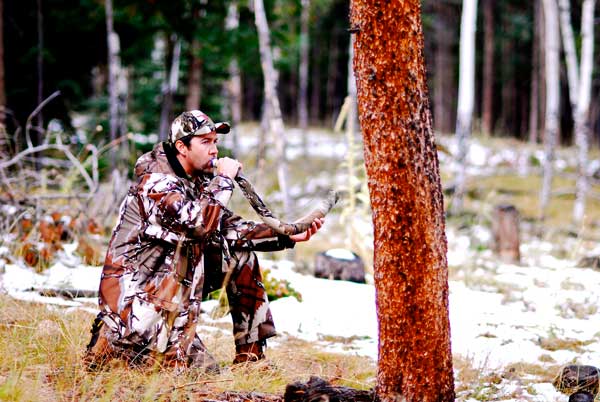Morning Hunt
Well the forecast overstated things just a wee bit. We got about another half an inch of snow, but nothing close to the foot that was projected. It was enough for clean tracks and we jammed out to hear the first calls while it was still dark. Sure enough, we hard bulls immediately. Yes, I did say, “Bulls.” We could hear at least three different distinct bugles.
We marched rather quickly down the hill, towards the most raspy sounding bull. Then the wind changed. One second it was a cross wind, the next it was from behind. We’re not sure if the herd caught or scent or if they were just moving out of the open anyway. None-the-less, we couldn’t catch up and they faded into the distance. It’s nearly impossible to keep up with elk going uphill in the snow.

Nearly two hours later, we got our eyes on a really nice, fat turkey hen. Oh boy! About 9 a.m., we gave blind calling a shot. Frank and Chris moved up a hill, at the convergence of several bowls. I tried to mimic a herd of feeding elk or calm elk. The bugles I tossed out were pretty quiet and conservative. I thought the whole calling sequence sounded pretty good. Obviously I wasn't convincing enough, there weren't any eager bulls in ear shot or it just wasn't the right time to call. The freak winter weather sure had things messed up and completely unpredictable. That one hen was all we saw the whole morning. What happened to hot elk action ... “if you’re lucky enough to get snow in bow season?”
Afternoon Hunt
It had stopped snowing, but it stayed cold and cloudy. The weather front was still keeping the animal activity to a minimum and it wasn’t until nearly last light that we finally saw elk again. We spotted a cow first and before long we got our eyes on eight cows and a crab-claw 6x6 bull. It was the exact same herd we’d seen the night before in the snow. (There was a trail cam we had placed right in the saddle and when we pulled the card the next morning, we had a couple great shots of the bull and his cows.)

The cows were grazing casually and the bull popped in and out of view as he paced back and forth behind the herd. We never got more a two or three second glimpse of him each time, but we saw him well enough to know he still wasn’t a shooter. He also wasn’t making any noise. I was just absolutely astounded that the cold had shut these elk up for the most part. I was expecting the exact opposite, since I’d had great luck in the few instances I’d experienced snow in September.
The best part about the day was going back to the lodge and knowing we had appetizers, Cornish game hens and big roaring fire. Once again, we did not have a hole punched in a tag, but we were seeing game and there was still four days to go.

Calling Tip:
In hunting and calling elk for most of my life, the one rule I stick to is … “No two calling sequences workout the same.” I think first-time elk hunters are both blessed and cursed by TV and videos. People see someone calling a bull into bow range and they get all hyped up. That part is great! It’s what’s left out that causes problems. It’s not hard to get a bull to respond. It’s not even that challenging to get one into 100 yards. The trick is getting a bull to walk past the shooter broadside at fifty yards or less; the close the better.
Nine times out of ten, I only use a cow call and that’s fifty-fifty between the old Carlton’s Fighting cow (to me it sounds most like a real distressed calf) and a diaphragm mouth call. I primarily only use my bugle in two ways. First, I throw out a loud, but somewhat shrill call as a “locator” call only. This is first light or early afternoon, when I want to find out where the elk are moving and get a notion as to how big of a bull I’m hearing. Second, I use that bugle only thereafter when I’m in tight and I just can’t get the bull to come into range.
Now the latter usually only works on dominant herd bulls. I will get aggressive, combined with frantic cow and calf calls. I’ll bugle with a hoarse ending or just grunt and chuckle. I also rake brush vigorously. Basically, I’m challenging the herd bull to fight for his harem. This typically is a last ditch effort as it ends one of two ways. The bull either picks up the gauntlet I’ve thrown down and charges in hard to fight. Or he decides that he doesn’t need to prove anything as he gathers his cows and leaves.
Exactly how much I call and how hard I challenge depends a lot on the behavior I witness. Again, no two calling sequences will work out the same. Watch videos produced by hunters who’ve killed multiple elk and really understand the psychology of calling. As for choosing the right call … you’ll have to try a few out and see which one you’re able to use the best. Most important to remember … real elk don’t sound like Kazoos.
|

